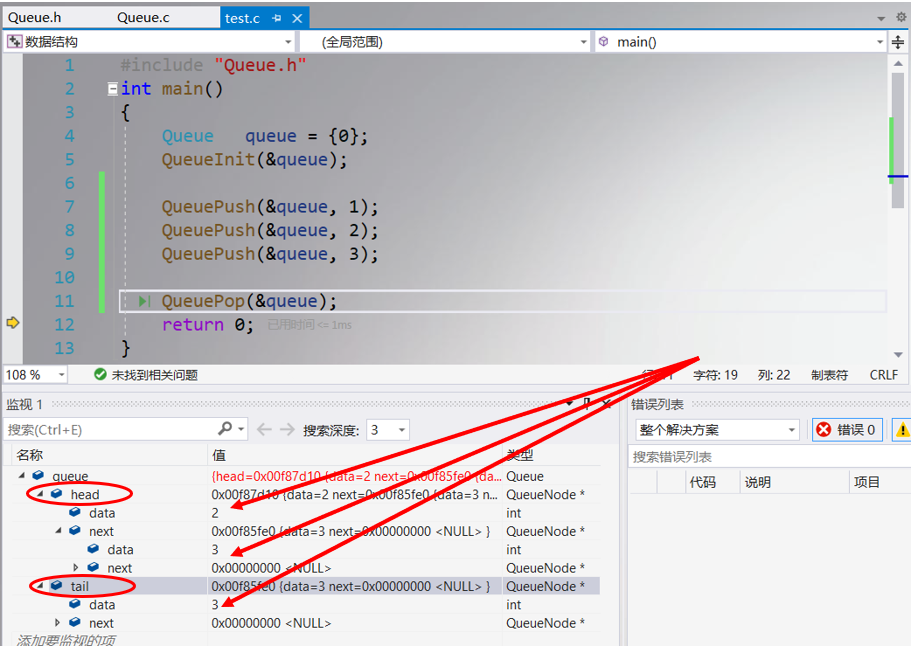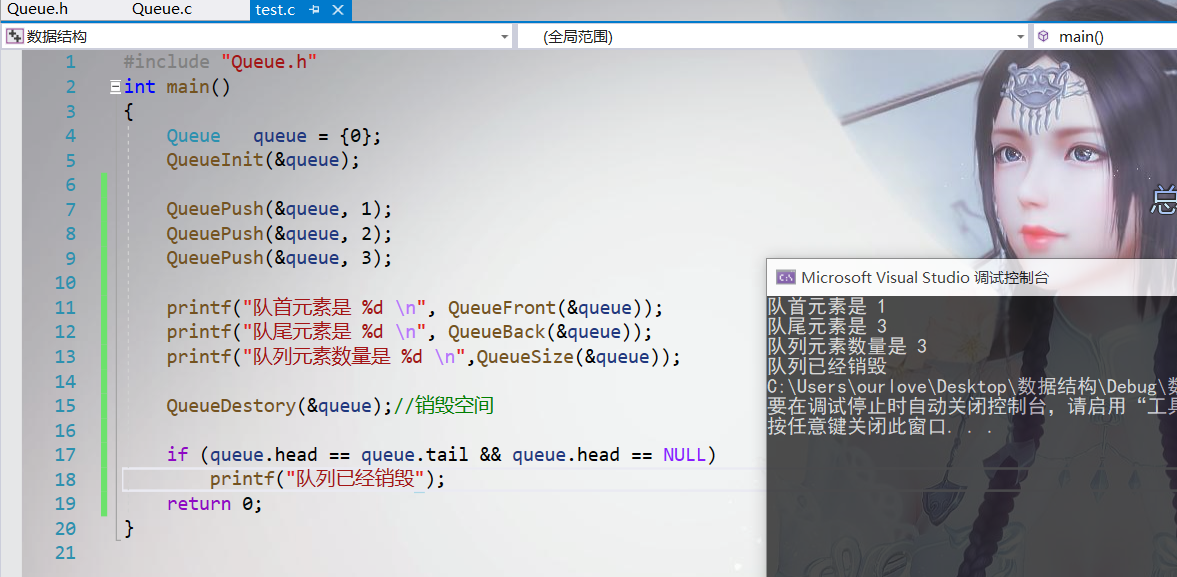preface
By and by, we have learned the sequence list, single linked list, double linked list and stack Today, what bloggers update is the queue in the data structure
1. What is a queue
Queue: a special linear table that only allows inserting data at one end and deleting data at the other end. The queue has the characteristics of first in first out
The end where only data insertion is allowed is called the end of the queue
Only one end of the data deletion operation is called the queue head
The deletion operation is called out of the queue, and the insertion operation is called in the queue
For all the above features, the blogger uses the following figure to show you:

2. How to implement queue
Since we want to implement the queue, we need to grab the supply according to the demand
So what are the main requirements of our queue? Yes, the answer is to join and leave the team
Join the team, there is no doubt that it is tail insertion operation, which is very convenient to realize with sequence table
Out of the team, there is no doubt that it is a header deletion operation, which is very convenient to realize with a linked list
In other words, we only consider the quality of the current operation. The linked list is the same as the sequence group. Let's consider the better possibility, huh ~ ~ Linked lists save more space than sequential lists
So we choose to implement the queue with linked list
However, if it is implemented with a linked list, the tail insertion operation is more troublesome (you need to traverse to the tail). How to solve this problem? Here, we use to open up another structure to contain the linked list nodes. There are only head and tail pointers in the new structure. Please see the next title for code implementation
3. Project construction
The blogger uses VS2019 here to demonstrate:
Create a queue first h,Queue. C and test C three documents
Queue.h is used to write file references and function declarations
Queue. The function of C is to write the definition of file function
test. The function of C is to test whether the written operation is correct

4. Define queue
Under the 2 title, it has been explained that the best way to implement the queue is to select the linked list structure and separate a structure for inclusion, so the following is the beginning of such implementation
typedef int QDataType;
typedef struct QueueNode //Define queue node
{
QDataType data;
struct QueueNode* next;
}QueueNode;
typedef struct Queue //Define queue
{
QueueNode* head; //Team leader
QueueNode* tail; //Team tail
}Queue;
5. All operations of the queue
For queues, we use the following operations most:
Queue entry (tail insertion), queue exit (head deletion), take the team head element, take the team tail element, judge the space, obtain the number of queue elements, and initialize and destroy space
So, bloggers first in queue All methods are declared in the H file and will be implemented in detail later
void QueueInit(Queue* pq); bool QueueEmpty(Queue* pq); void QueuePush(Queue* pq, QDataType x); void QueuePop(Queue* pq); QDataType QueueFront(Queue* pq); QDataType QueueBack(Queue* pq); int QueueSize(Queue* pq); void QueueDestory(Queue* pq);
5.1 queue initialization
After we create a queue, the head and tail pointers of the queue are still wild pointers, so we initialize it to NULL
void QueueInit(Queue* pq)
{
assert(pq);
pq->head = pq->tail = NULL;
}
Test successful:

success!!
5.2 empty judgment of queue
Judge empty, that is, judge whether the queue is empty. How to judge? As long as the header pointer does not point to any space, the queue is empty
bool QueueEmpty(Queue* pq)
{
assert(pq);
return pq->head == NULL;
}
5.3 queue entry
Join the team, that is, tail insertion. In the previous linked list and sequence chapters, we are still familiar with this operation:
The first step is to open up a new space to store data
Step 2: Tail - > next points to the new node (just note that when the linked list is empty)
void QueuePush(Queue* pq, QDataType elem)
{
assert(pq);
QueueNode* newnode = (QueueNode*)malloc(sizeof(QueueNode));
if(newnode == NULL)
{
perror("Reason for space application failure:");
exit(-1);
}
newnode->data = elem;
newnode->next = NULL;
//Note whether the queue here is empty
pq->head == NULL ? (pq->tail = newnode ):(pq->tail->next = newnode,pq->tail = pq->tail->next);
}
Test:

success!!!
5.4 leaving the queue
Obviously, when you leave the team, you delete the header. We are also familiar with the header deletion operation:
First, save the next node
The second step is to release the header node
Step 3: point to the next saved node
void QueuePop(Queue* pq)
{
assert(pq);
assert(!QueueEmpty(pq)); //If the queue is empty, it cannot be deleted
QueueNode* next = pq->head->next;//Save next node
free(pq->head);//release
pq->head = next;//Point to the next node
}
Test successful:

Success??? Have you finished? Let's take a closer look at the above code and think about where there will be bugs
Yes, when there is only one node left at the end of the queue, the tail will be a wild pointer, as shown in the following figure:
You will find that when the last one is left, the tail still points to the original position to form a wild pointer

Modification code:
void QueuePop(Queue* pq)
{
assert(pq);
assert(!QueueEmpty(pq)); //If the queue is empty, it cannot be deleted
QueueNode* next = NULL;
pq->head->next == NULL?
(free(pq->head),pq->head = pq->tail = NULL):
(next = pq->head->next, free(pq->head),pq->head = next);//Conditional expression
}

Now the test is really successful
5.5 acquisition of queue leader
This is relatively simple and can be returned directly
QDataType QueueFront(Queue* pq)
{
assert(pq);
assert(!QueueEmpty(pq)); //Cannot be empty
return pa->head->data;
}
5.6 obtaining queue tail
Similarly, return directly
QDataType QueueBack(Queue* pq)
{
assert(pq);
assert(!QueueEmpty(pq)); //Cannot be empty
return pa->tail->data;
}
Test successful:

success!!
5.7 number of return queue elements
This directly opens a variable num, and then traverses the queue for counting
int QueueSize(Queue* pq)
{
assert(pq);
int num = 0;
QueueNode* cur = pq->head;
while(cur)
{
num++;
cur = cur->next;
}
return num;
}
5.8 queue destruction space
Destroy each space one by one
void QueueDestory(Queue* pq)
{
assert(pq);
QueueNode* cur = pq->head;
while (cur)
{
QueueNode* next = cur->next;
free(cur);
cur = next;
}
pq->head = pq->tail = NULL;
}
Test successful:

success!!!
Total code
Queue.h header file
#pragma once
#include<assert.h>
#include<stdio.h>
#include<stdlib.h>
#include<stdbool.h>
typedef int QDataType;
typedef struct QueueNode //Define queue node
{
QDataType data;
struct QueueNode* next;
}QueueNode;
typedef struct Queue //Define queue
{
QueueNode* head; //Team leader
QueueNode* tail; //Team tail
}Queue;
void QueueInit(Queue* pq);
void QueueDestory(Queue* pq);
void QueuePush(Queue* pq, QDataType elem);
void QueuePop(Queue* pq);
int QueueSize(Queue* pq);
QDataType QueueFront(Queue* pq);
QDataType QueueBack(Queue* pq);
bool QueueEmpty(Queue* pq);
Queue.c source file
#include "Queue.h"
void QueueInit(Queue* pq)
{
assert(pq);
pq->head = pq->tail = NULL;
}
void QueuePush(Queue* pq, QDataType elem)
{
assert(pq);
QueueNode* newnode = (QueueNode*)malloc(sizeof(QueueNode));
if (newnode == NULL)
{
perror("Reason for space application failure:");
exit(-1);
}
newnode->data = elem;
newnode->next = NULL;
//Note whether the queue here is empty
pq->head == NULL ?
(pq->tail = pq->head = newnode) : (pq->tail->next = newnode, pq->tail = pq->tail->next);
}
void QueuePop(Queue* pq)
{
assert(pq);
assert(!QueueEmpty(pq)); //If the queue is empty, it cannot be deleted
QueueNode* next = NULL;
pq->head->next == NULL ?
(free(pq->head), pq->head = pq->tail = NULL) :
(next = pq->head->next, free(pq->head), pq->head = next);//Conditional expression
}
int QueueSize(Queue* pq)
{
assert(pq);
int num = 0;
QueueNode* cur = pq->head;
while (cur)
{
num++;
cur = cur->next;
}
return num;
}
QDataType QueueFront(Queue* pq)
{
assert(pq);
assert(!QueueEmpty(pq));
return pq->head->data;
}
QDataType QueueBack(Queue* pq)
{
assert(pq);
assert(!QueueEmpty(pq));
return pq->tail->data;
}
bool QueueEmpty(Queue* pq)
{
assert(pq);
return pq->head == NULL;
}
void QueueDestory(Queue* pq)
{
assert(pq);
QueueNode* cur = pq->head;
while (cur)
{
QueueNode* next = cur->next;
free(cur);
cur = next;
}
pq->head = pq->tail = NULL;
}